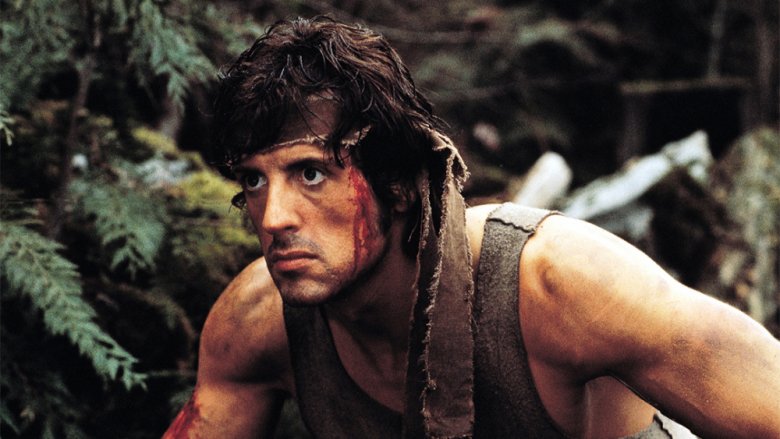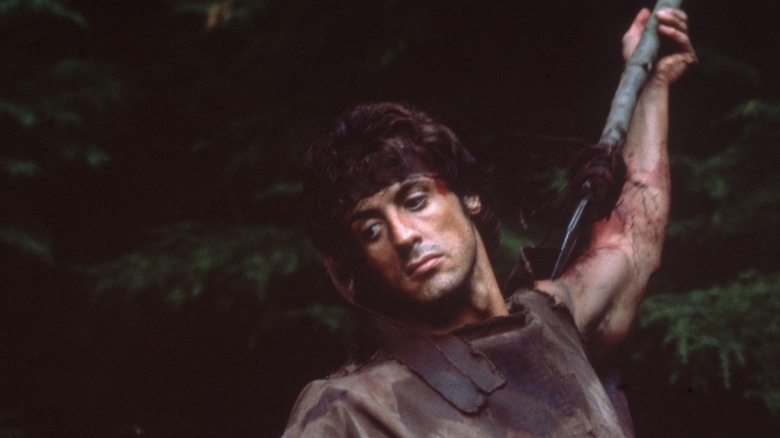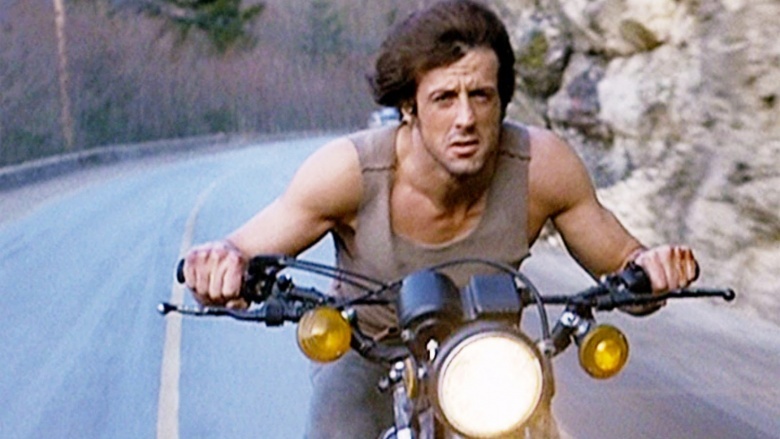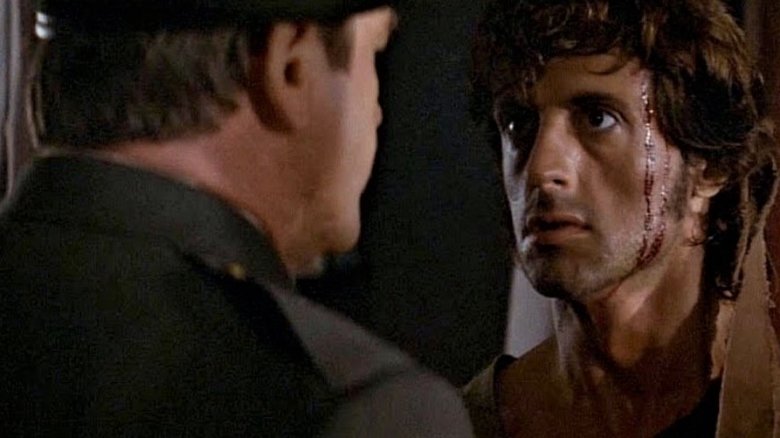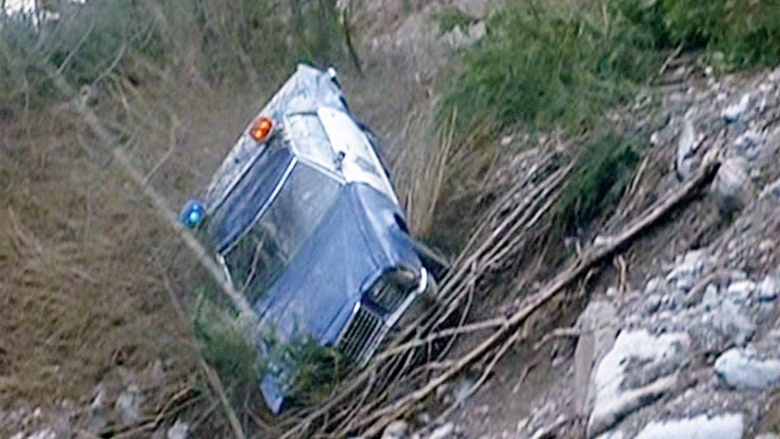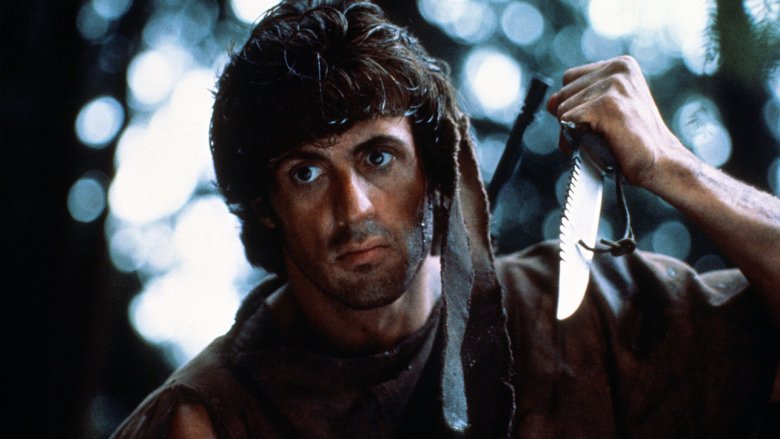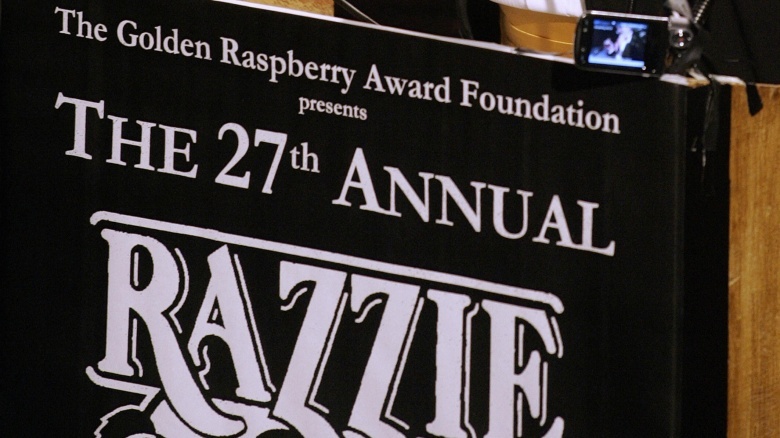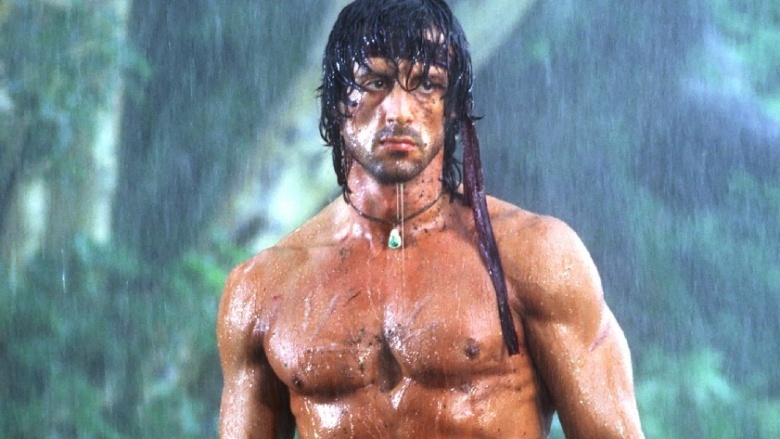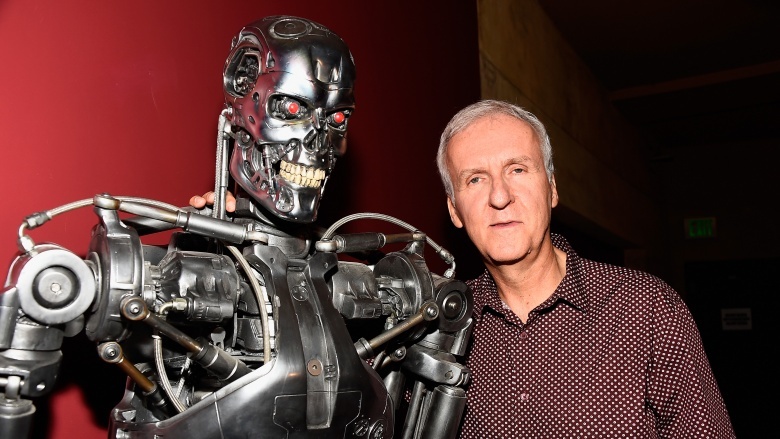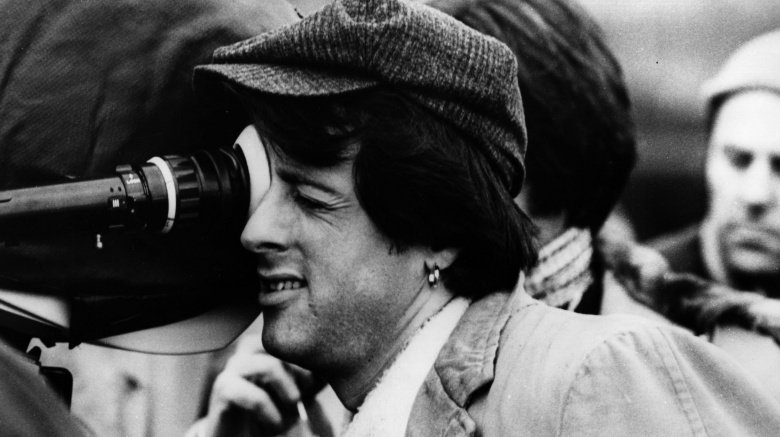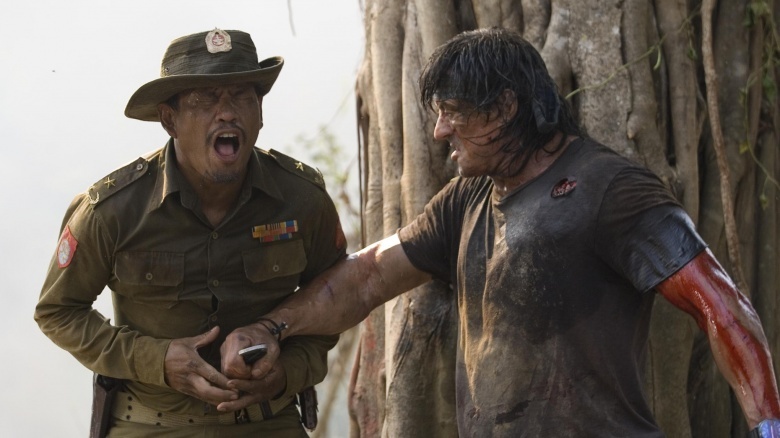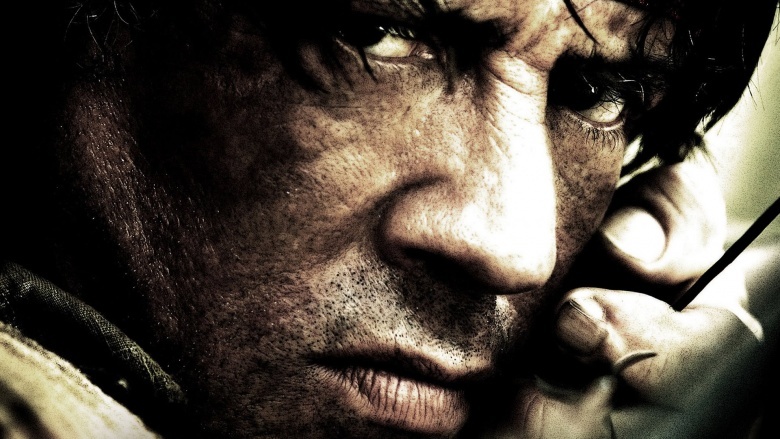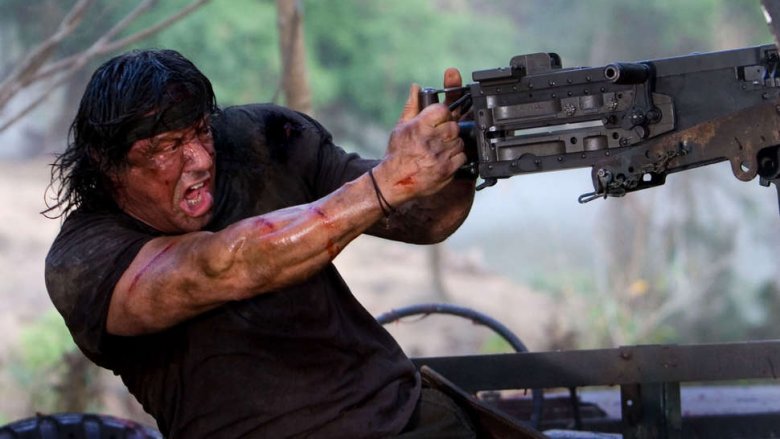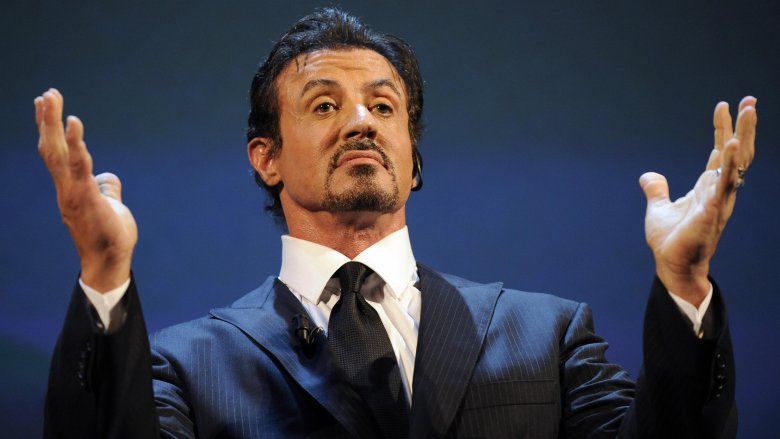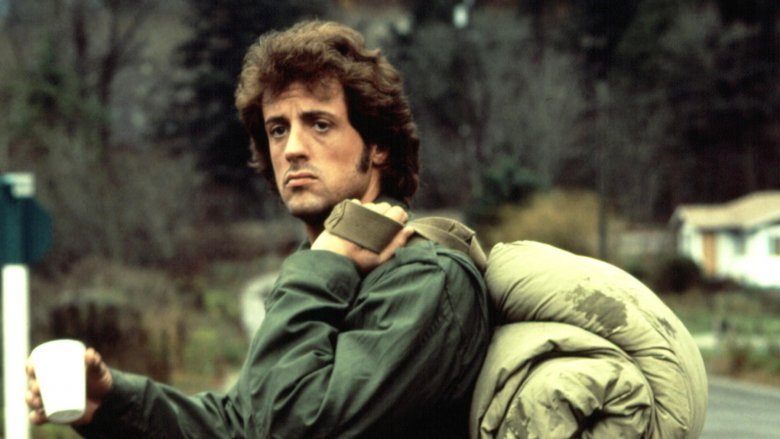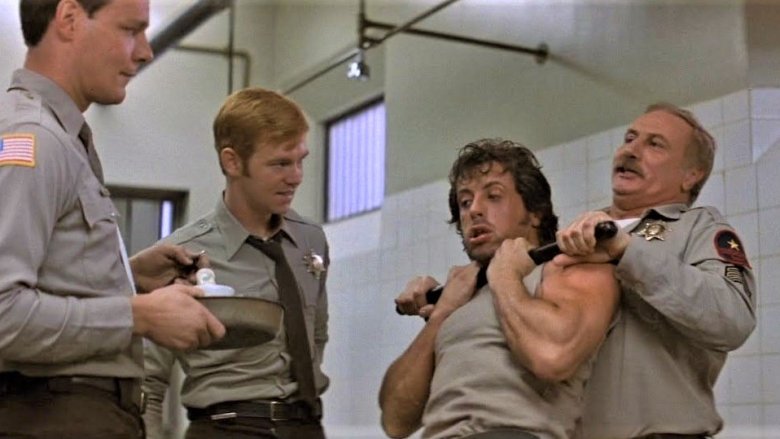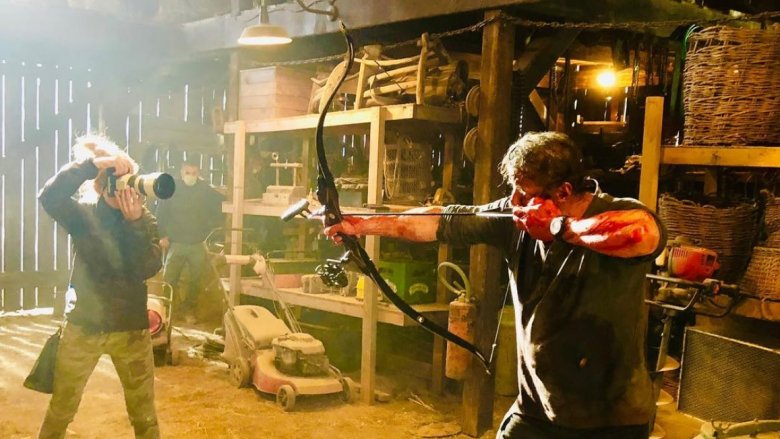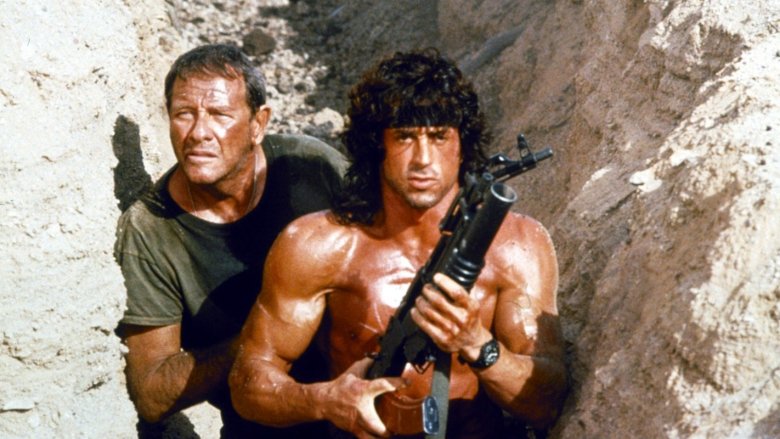The Untold Truth Of Rambo
It's hard to imagine anyone but Sylvester Stallone wearing John Rambo's famous sweatband, but he was far from first choice for the role. According to Stallone, Robert De Niro, Al Pacino, Paul Newman, James Caan, Nick Nolte, Robert Redford, and Burt Reynolds were all considered before him. "I think they were going to lab animals before they got to me," he told Howard Stern in 2019. First Blood had been kicking around Hollywood for so long by the time Stallone got a call that he almost passed on it. "It was kind of a jinxed project," he said. "It had been around so many actors and gone through many changes with directors, and I was very nervous. As a matter of fact, the day of filming I was hoping that it would never happen, that it would just go away."
Despite Stallone's reservations, First Blood became one of the defining films of the 1980s. The first sequel, 1985's Rambo: First Blood Part II, managed to surpass it at the box office, but the critics were not so receptive. 1988's Rambo III and 2008's Rambo both failed to reach the high bar set by the original, but Stallone has promised a "very intense" finale in Rambo V: Last Blood. The character will remain forever ingrained in pop culture, regardless. No amount of substandard sequels can change the fact that John Rambo is one of the most influential action heroes in film history, but how much do you really know about him?
It all started with a novel
The story of Vietnam War veteran John Rambo was first told in David Morrell's 1972 debut novel First Blood, a huge hit for the Canadian-born author that has been translated into as many as 26 different languages since publication. To this day, the book has never gone out of print, remaining popular among readers and fellow writers alike (Stephen King used it as one of his core texts while teaching creative writing at the University of Maine), though the film version of First Blood deviated from Morrell's novel on a number of occasions in terms of tone.
While the novel jumps back and forth between Rambo and Sheriff Teasle's viewpoints so the reader is always unsure as to who is in the right (the key to the story's success, according to the author), the film does everything in its power to paint Rambo as the undisputed hero of the story. An early example of this is the scene in which Rambo is jailed for being a bearded vagrant and experiences a Vietnam flashback when confronted with a razor. In the movie, Rambo simply escapes police custody after the deputy in question continues to harass him, while in the book, the former POW takes the razor from the guard and proceeds to gut him. Sylvester Stallone's take on the character is far less violent, going through the entire film without directly killing a single man.
Stallone was "very close" to being killed in the motorcycle chase
After escaping custody, Rambo finds himself on foot with armed officers in close pursuit. Luckily for him, a man passing on a Yamaha XT250 presents an opportunity for escape. The spooked vet pulls the motorcyclist from his bike and uses it to lead the police on a chase through the town and the dense woodlands beyond—a well-shot scene with many of the twists and turns handled by Stallone himself. It wasn't quite as easy as the leading man made it look on film, however. Sly revealed that the freezing weather they experienced while filming on location in British Columbia presented a certain set of problems, though nobody predicted that the driver of an 18-wheeler would ignore the crew and use the road where they were filming the chase.
"It was very dangerous," admitted Stallone. "Just before I came off the road, we almost had a head-on collision. The stunt people tried to block off the highways, but they couldn't, and this one truck came by ... let me tell you, it was very, very close. I was ready to shake hands with the angels."
Rambo was named after a type of apple
Morrell's inspiration for Rambo as a character came from a real-life World War II veteran named Audie Murphy, one of the most decorated soldiers in the history of the U.S. military. Murphy earned every combat award for valor that the Army bestows, including the Medal of Honor, which he received at 19 after single-handedly holding off an entire company of Nazi soldiers for a full hour before personally leading a successful counterattack. Morrell took this story of heroism and, after seeing harrowing images of the Vietnam War on TV, decided to update it.
With the character in mind, the author still needed a name, and he found himself struggling to come up with something that was original but also conveyed strength. He later revealed that the name came to him after his wife brought home some fresh apples from a local roadside market. Morrell bit into one of the apples and asked what type it was, to which she replied "Rambo." He went straight to his typewriter to work on First Blood.
He was supposed to die at the end of First Blood
Perhaps the biggest difference between First Blood the novel and First Blood the action movie is that, in the book, Rambo dies at the end. Horrifically. The Vietnam vet and the dogged Sheriff Teasle face off in an epic showdown in which Rambo, physically and mentally exhausted, considers blowing himself up with his remaining grenades. He doesn't get the chance, however — before he pulls the pins, Colonel Trautman blows him away with a shotgun, killing the soldier he created.
The first cut of First Blood ended in a similar fashion, with Rambo grabbing Trautman's gun and pulling the trigger on himself. According to director Ted Kotcheff (per Entertainment Weekly), Stallone pulled him to one side after they shot the scene and implored him to change his mind. "He said, 'You know, Ted, we put this character through so much. The police abuse him. He's pursued endlessly... All this, and now we're gonna kill him?'"
One person who really didn't want Rambo to survive the film was Kirk Douglas. The veteran actor was originally signed on to play Trautman (promotional material featuring him in character was even produced), but complications arose when he turned up to the first day of the shoot with a revised script. "He said to me: 'Here's what I want,'" Stallone recalled. "'At the very end of the movie I should kill you.'" Douglas wanted to drive off into the sunset wearing Rambo's now-iconic bandana. His request was denied and he left for the airport the next morning.
Legendary stuntman Bennie E. Dobbins broke his back on set
The late Bennie E. Dobbins was a third-generation stuntman who plied his trade in everything from Star Trek in the 1960s to a host of action flicks in the '80s, including Commando, The Running Man, and First Blood. It was during the making of the latter film that he was involved in a botched car jump that left him with a broken back. A local paramedic who was invited to oversee the railroad track and cliff jump scenes later gave his account of the accident, claiming that director Ted Kotcheff instructed Dobbins to approach the stunt ramps set up for the train track jump at 70mph.
"The result was that the huge Ford LTD launched so high that it would have cleared a telephone wire had one been strung across the shot," alleged the paramedic. "The car came down well beyond the three railway tracks and on all four wheels simultaneously, instantly stopping the engine while the car, still doing about 40 miles an hour, rolled down the road... the silent car gradually rolled to a stop, the drivers door opened, and Dobbins fell out onto the road."
Dobbins suffered a compression lumbar fracture, an injury that involves a vertebral bone in the spine decreasing in height by up to 20% upon impact. He refused to let it end his career, however, continuing to work throughout the 1980s both as a coordinator and occasional performer until he died suddenly from a heart attack at the age of 56 on the set of Arnold Schwarzenegger's Red Heat.
There were 17 different screenplays
Stallone has described First Blood as being "cursed" on more than one occasion, and he wasn't only talking about narrowly avoided head-on collisions and crushed vertebrae. The sheer number of people that had to be brought in to get the script in shooting shape was staggering—striking the right balance between the morally questionable carnage of the novel and the need to create a likable onscreen hero proved difficult. Producers even turned to Broadway screenwriter David Rein in their desperation, but he couldn't give them what they were looking for.
A total of 17 different First Blood scripts were completed between 1972, when the rights were purchased, and the start of production almost a decade later. Some of them were "very, very good screenplays" according to Stallone, but in the end, the shooting script was a combination of work by Michael Kozoll, writer of 1991 buddy comedy The Hard Way, and William Sackheim, whose other screenwriting credits include the 1980 Richard Dreyfuss drama The Competition. Stallone himself made several revisions of his own, a habit he would continue for the duration of the franchise.
First Blood Part II cleaned up at the Razzies
The game plan behind the first sequel in the series was simple—bigger and bloodier. Rambo: First Blood Part II begins with an incarcerated (and visibly more muscular) Rambo being offered an out by Colonel Trautman if he agrees to return to Vietnam and help the government rescue some POWs. The difference in tone is set early on when the titular hero throttles a rattlesnake with his bare hands, and what follows is a borderline ludicrous adventure through the jungles of Southeast Asia, with Rambo leaving a trail of carnage in his wake.
Despite an impressive showing at the box office, Rambo: First Blood Part II was repeatedly panned by critics on its way to being named the Worst Picture of 1985 at the following year's Golden Raspberry Awards. The film ended the night with four Razzies, also taking home the Worst Screenplay and Worst Original Song accolades as well as Worst Actor for Stallone, who was also nominated for his performance in Rocky IV. The film has the lowest Rotten Tomatoes score of the franchise (30 percent), described by Rotten Tomatoes top critic Vincent Canby as "so comic that Rambo turns into something of a camp classic."
The set was devastated by a hurricane
The curse that Stallone insisted hung over First Blood seemed to follow him to Part II as the production of the high-octane sequel was hamstrung by a number of problems—some avoidable tragedies, others acts of God. The crew lost one of their own when special effects consultant Cliff Wenger Jr. was killed by an explosion that went off prematurely, though they all could have died if they hadn't chosen to abandon the set before it was devastated by a tropical storm.
Back then, most films looking to recreate the events of the Vietnam War chose to shoot in nearby Thailand (Good Morning, Vietnam being a prime example), which still had a number of relatively undeveloped towns that closely resembled parts of their communist neighbor's country during the time of the conflict. Whether it was for financial or logistical reasons, the studio took a different path and chose to shoot in the jungles of Mexico instead. It was a decision that would prove costly, as 1984 ended up having a very active Pacific hurricane season. The cast and crew were forced to give up their set to Mother Nature as Hurricane Odile made landfall and wreaked havoc.
James Cameron's First Blood Part II script was novelized
James Cameron enjoyed a creative purple patch in the early '80s, writing and directing the seminal sci-fi films The Terminator and Aliens, though he's always made an effort to distance himself from one particular entry in that era of his filmography. Cameron has a co-writing credit for First Blood Part II, but the script he wrote differed from the final draft considerably, with the tech-savy sidekick that he intended to tag along with Rambo cut and the levels of violence ramped up to what the future Avatar director considered "amoral." Just as he did with the first film, Stallone substantially re-wrote the screenplay, though one person who became a fan of Cameron's original script was First Blood author David Morrell.
It wasn't uncommon for producers at the time to hire writers to create novelizations of their movies, though the authors would be restricted to adding in mere description, unable to change the scenes or dialogue under any circumstances. Morrell agreed to write the First Blood Part II book as long these rules didn't apply to him, and the producers relented, allowing him access to previous versions of the screenplay. The one that struck him was the unedited Cameron script. "I asked to see the script and struck gold," he recalled. "In the end, my novelization was one-third original material from me, one third adaptation of James Cameron, and one third the final script. Those many differences between the film and the novelization had never been allowed before or since."
Stallone ghost-directed Part II
Rambo: First Blood Part II aside, the film George P. Cosmatos is best known for is 1993's Tombstone, though according to the star of the critically acclaimed Western, the director had little to do with either film. Kurt Russell revealed that he called Stallone for advice after Tombstone screenwriter Kevin Jarre was relieved of his duties as the film's director, hoping to bring in someone that would let him direct the film in everything but name. Stallone recommended Cosmatos, because this was the exact arrangement they had for the second Rambo film, as Russell explained during an interview conducted after Cosmatos' death.
"They wanted me to take over the movie. I said, 'I'll do it, but I don't want to put my name on it.' I'd go to George's room, give him the shot list for the next day, that was the deal," Russell explained. "I got him from Sly Stallone. Sly did the same thing with Rambo 2 with George. And I said to George, 'While you're alive, George, I won't say a goddamn thing.'"
Rambo is banned in Myanmar
2008's Rambo takes place many years after the events of 1988's Rambo III, with John having settled down in Thailand to work as a snake wrangler, fisherman, and occasional guide. When a group of Christian missionaries he leads into neighboring Myanmar are abducted by the corrupt military, however, the wizened vet must take on the country's brutal army to get his clients back safely. The movie's depiction of the army led to it being banned outright in Myanmar, though it still became popular through word of mouth.
"Many customers keep asking about Rambo IV but I dare not to sell it," a pirate DVD seller based in Rangoon told The Telegraph. "Police have warned me I could go to jail for up to seven years." Despite the threat of the police and military looming large (there were reports of rapes and murders at the hands of soldiers), many locals managed to obtain copies of the film, much to Stallone's delight. "They've actually used some of the film's quotes as rallying points," the actor said. "That, to me, is one of the proudest moments I've ever had in film."
Over a decade has passed since Rambo's release, but Myanmar's ethnic groups are still at odds with the country's government, which clearly hasn't forgotten about John Rambo. In 2017, imprisoned activist Ko Min Htay (who starred in Rambo as a sadistic army officer) was told that his involvement in the film was likely to result in additional criminal charges.
He almost fought a genetically engineered super soldier
Talk of a follow-up to 2008's Rambo started to circulate as soon as the dust settled on the fourth film, with initial reports indicating that the fifth installment would involve everyone's favorite one-man army single-handedly rescuing a young woman abducted somewhere along the Mexican border. The general consensus among commentators was that Rambo V was going to follow in the footsteps of global smash Taken, however Stallone himself read the rumors and chose to intervene with the facts. In a voice message Sly left with Ain't It Cool (which can be heard here), the star revealed that he actually intended to pit Rambo against a genetically engineered beast escaped from a military facility in his old stomping grounds of the Pacific Northwest.
Stallone was wary of comparisons to films like Universal Soldier, insisting that what he had in mind was closer to the plot of '50s sci-fi classic Forbidden Planet in which a doctor allows his subconscious to turn him into a killing machine. He described Rambo's enemy this time out as "an amalgamation of fury and intelligence and pure unadulterated rage. Its before men became human, this is when they were still inhuman, and so what he confronts is something that is everyone's virtual nightmare... he's going against a feral beast that has absolute cunning and intelligence and a will to survive that is only matched by Rambo's." A one-sheet was even circulated around the Toronto Film Festival, revealing the proposed title as Rambo V: The Savage Hunt.
The truth about those Rambo v. ISIS rumors
The Rambo franchise seemed poised to expand rapidly after 2008's Rambo. Stallone started promoting his Savage Hunt idea the following year, though despite the actor's eagerness the project never got off the ground. Five years then passed with no news on a sequel. Then, in 2014, Stallone revealed that the fifth Rambo movie had a title in an out-of-the-blue tweet: Rambo: Last Blood.
Fans immediately started to speculate about who the former Green Beret would be going up against this time around. Before long, rumor was being reported as fact. A fake news story that led people to believe they were going to witness Rambo fighting Islamic State was heavily circulated, complete with supposed quotes from the star. "We have teams scouting Iraq and parts of Syria where ISIS have their greatest strongholds," Stallone reportedly said during Comic-Con 2015 (via The Guardian). "We're working with the locals there to help deliver the most intense and realistic Rambo movie experience ever."
The story got so big that Stallone's management released a statement on the matter, confirming that the quotes were indeed false. The following year, the actor claimed that he'd retired from playing Rambo altogether. "The heart's willing, but the body says 'Stay home,'" he said (via Variety). "When they asked me to do another Rambo, I said, 'If I can't do better than I did last time — and I can't — then why?'" In the end, Sly listened to his heart over his body. Shooting on the long-gestating Last Blood wrapped in 2018.
Is the reboot still happening?
When Stallone briefly retired from playing Rambo in 2016, a reboot of the property was promptly floated by Millennium Films, home of the Expendables franchise. The Hollywood Reporter obtained exclusive details of the project, which was going under the most obvious (but still pretty cool-sounding) name of New Blood. Millennium reportedly wanted to turn Rambo into a James Bond type character, in that the role would be passed from actor to actor as and when the studio saw fit. There was no news on a new lead, but THR confirmed that How It Ends writer Brooks McLaren had been asked to write the screenplay while Israeli director Ariel Vromen (Criminal) was set to helm.
Whether or not this reboot will kick back into production after the release of what will surely be Stallone's final outing as Rambo is unclear, but one project that we know for sure is dead in the water is the Rambo TV series. The show (which was also rumored to be titled New Blood) was conceived by First Blood writer David Morrell, who wanted to tell the story of Rambo's son. Morrell envisioned Stallone guest-starring from time to time, but he struggled to come up with a convincing narrative and eventually abandoned the idea. "The whole point is that Rambo had been so traumatized by the war that he couldn't bring himself to have a meaningful relationship, let alone have a child," the author told Digital Spy in November 2018. "So to my knowledge, that never went anywhere."
Stallone tried to destroy First Blood before it got released
The version of First Blood that was released in theaters differed greatly from the very first cut of the film, according to the leading man. When Stallone sat down with Howard Stern in February 2019, he revealed that the first Rambo movie was originally so bad that he and his manager actually tried to get their hands on it so they could destroy it. "I think we both went out and retched in the alley," Stallone said of the disastrous first viewing. "We tried to buy it back and burn the negatives. On my children, we tried to buy it back and burn the negatives."
Stallone told a visibly shocked Stern that the first cut of the now-revered First Blood was way too long and packed full of super cheesy one-liners. "I stayed an hour and a half in the woods chasing guys," the star of the franchise said. "I shoot an owl, and then the owl drops and I go, 'Take that you mouse-munching mother...'. I said, 'I can't say that!'" When Stern asked how they went about rescuing the movie, Stallone revealed the one simple fix that turned First Blood from a schlocky '80s actioner into a classic.
"I said, 'Here's a good idea, cut out all my dialogue — every line," Stallone said. "Have other people talk about you... Other people fill in the blanks... And I think that works."
First Blood's sketchy stunts left Stallone 'black and blue'
We've already discussed the near-death experience Stallone had while filming First Blood's motorcycle chase, but that was far from the only sketchy stunt he took part in during the making of the movie. In fact, the scene prior to his high-speed motorcycle escape was also a particularly testing one for the actor. Rambo takes a beating from the sheriff's deputies before he manages to flee into the wilderness, and it wasn't an easy sequence to film. "That took like 19 takes," co-producer Andrew Vajna recalled. "Sly was black and blue by the time the shot was over."
Stallone has confirmed that he was in and out of the hospital during the making of First Blood, becoming something of a regular at the local emergency room. "There was a vast array of stunts that were very, very, very dangerous," he said. "As a matter of fact, the first stunt was falling through the tree. We had gotten it on the first take, we did two more takes and I said, 'Please can we stop now 'cause it's starting to hurt.' Of course, on the fourth take I broke my rib and I bruised my spleen."
According to Richard Crenna (Trautman), Stallone performed 75 percent of all Rambo's stunts in the movie, often volunteering to do the most difficult ones himself — and he did it all while wearing a tiny vest. "The temperatures were extraordinary," Crenna said of the Canadian winter. "It really got down to 40 degrees below with the windchill."
Rambo V did 'a lot of damage' to Stallone's body
Bumps and scrapes come with the territory when you're a Hollywood action hero, though Stallone has had more than his fair share of knocks over the years. The actor did some serious damage to his back while filming the third entry in his Expendables franchise, but (despite needing surgery to fix it) he wouldn't be deterred. "I grade the quality of a film by the intensity of the injuries," Stallone joked (via The Mirror). "Through Rambo and The Expendables, I break my neck and my spine and I dislocate both shoulders."
Stallone was 72 years old when filming on Rambo V kicked off, but he didn't let that slow him down. Reports that he had been taken to the hospital following an accident on the set of Last Blood emerged at one stage, though the seriousness of the injury was downplayed. The man himself later revealed that shooting the sequel at his age did take a toll on him.
"It's been a long time since I've been in the gym because I've been out there doing Rambo, which caused a lot of damage," he said during a mid-workout Instagram post. "So now I've got to fix things. Coming back here, let's face it, it's not easy. Who wouldn't rather be in bed just relaxing a little bit? But listen, life is like a movie. You gotta star in your own feature. And if you want to play the lead, you got to get out there and go after it. See you soon."
Rambo's combat history finally revealed
For decades, all we've really known for sure about Rambo's military history is that he's a Vietnam vet and former Green Beret, the popular name for the United States Army Special Forces. His rank and unit have never been specified, but hints about his past have been dropped on occasion. In First Blood, Trautman reveals that Rambo is a Congressional Medal of Honor winner and a "survivor of countless incursions behind enemy lines." One of the most telling moments was actually cut from Rambo III — a deleted scene that gave a brief glimpse of Rambo's uniform confirmed that he'd been awarded both American and South Vietnamese medals.
In 2019, Stallone decided to end the debate. At least, that's what he intended to do. The actor posted a picture of his younger self in uniform to Instagram, along with the caption: "Rambo at 20... In '68 was an AIR FORCE chopper pilot, in '70 transferred to SPECIAL FORCES to '75, then enlisted in DELTA FORCE from '77 to '78." It seemed like Sly had it all covered, but it didn't take long for the internet to start picking holes in the actor's version of events.
"No and no to 101st CAG candidate AND a helo pilot at 20 — don't care what medal someone has," one user who claimed to be privy to the selection process replied (via ComicBook.com). "Two of my lifer teammates were recruited in at 36 and 38 respectively. So in army movie land yeah, but not for the marines anyway."
